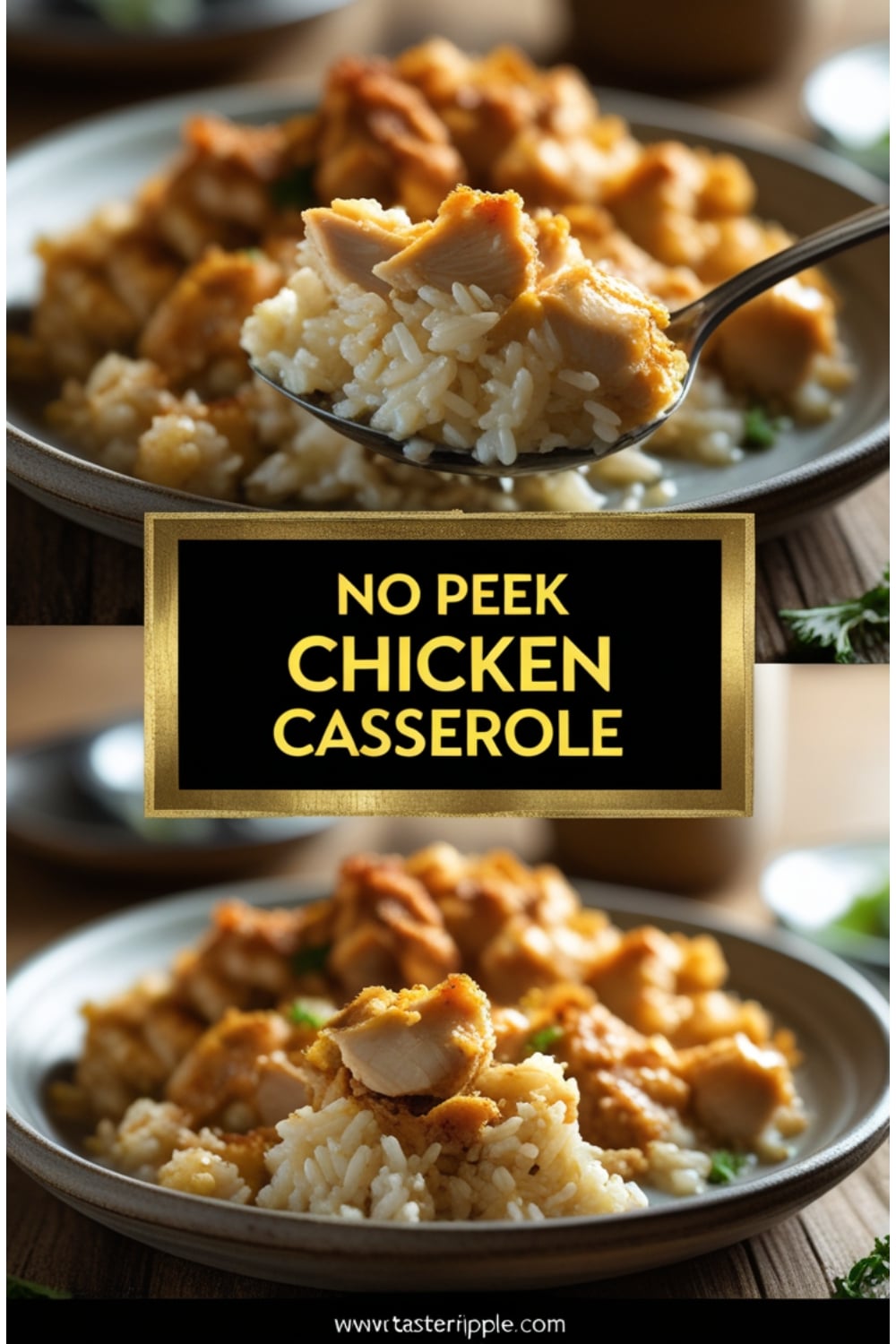I still remember the first time I heard the words “No Peek Chicken.” I thought someone was joking. How could you cook something properly if you weren’t allowed to look at it? My aunt pulled the dish from her old 70s oven, steam puffing out like a magician’s trick, and the smell of buttery rice and slow-cooked chicken filled the kitchen. I was hooked before I even took a bite.
That’s the charm of this casserole. It’s a dish built on patience and trust. You set it up, cover it tight, and let the oven do the heavy lifting. No fussing, no stirring halfway, no lifting lids to check—hence the name. And when it comes out, you get chicken so tender it falls off the fork, rice that’s absorbed every ounce of flavor, and edges that have browned just enough to whisper “eat me now.”
It’s not a fancy dish. But it’s honest food. Comfort food. The kind of recipe that has traveled through kitchens across America since the 70s, each cook adding their own spin. Some swear by cream of mushroom soup, others swear at it and replace it with homemade béchamel. But the idea stays the same: chicken, rice, broth, cover, and don’t peek.
Why No Peek Chicken Casserole Works
At its heart, the dish is about steam management. The sealed pan traps heat and moisture, forcing rice to soak up broth slowly while chicken cooks gently above it. No stirring required, no timing nightmare. It’s forgiving, almost foolproof, which is why it became a potluck darling decades ago.
But there’s science too. The starch from the rice thickens the liquid as it bakes, turning broth and soup into a rich sauce that clings to every bite. Chicken thighs work particularly well here because their fat melts into the rice, enriching it like butter would. You could use breasts, but thighs bring the magic.
And there’s nostalgia. Every family has some version, usually passed scribbled on a recipe card with a few sauce stains. To professionals, it’s a study in low-and-slow oven cooking. To home cooks, it’s dinner that doesn’t need babysitting.
Ingredients & Substitutions
Let’s build the base. Below is a standard ingredient list for a 9×13 casserole, serving about 6 people.
| Ingredient | Measurement | Notes & Substitutions |
|---|---|---|
| Chicken thighs (bone-in, skin-on or skinless) | 6–8 pieces | Breasts can be used, but thighs stay juicier |
| Long-grain white rice (uncooked) | 2 cups | Jasmine or basmati work, but avoid short-grain |
| Cream of mushroom soup | 1 can (10.5 oz) | Swap with cream of chicken or homemade béchamel |
| Cream of celery soup | 1 can (10.5 oz) | Adds depth; can double mushroom if you prefer |
| Chicken broth | 2 cups | Low-sodium best to control saltiness |
| Onion powder | 1 tsp | Fresh onion (½ cup finely diced) is even better |
| Garlic powder | 1 tsp | Fresh garlic (2 cloves minced) can be used |
| Paprika | 1 tsp | Smoked paprika adds more character |
| Salt | 1 tsp | Adjust based on broth used |
| Black pepper | ½ tsp | Fresh cracked pepper for best punch |
| Butter | 2 tbsp, melted | Optional, brushed on chicken for golden top |
| Parsley (fresh) | 2 tbsp, chopped | For garnish and brightness |
Ingredient insights
The rice choice matters. Long-grain rice like basmati holds shape, doesn’t gum up, and absorbs liquid evenly. If you try brown rice, you’ll need to extend baking by about 20–25 minutes and increase liquid slightly.
Soups give that retro creaminess. Purists may sneer at canned soups, but they bind the casserole beautifully. Professionals often replace them with a homemade roux + stock + cream blend, which gives more control over flavor and salt.
And chicken—bone-in thighs yield better flavor because marrow and connective tissue add body to the sauce. But boneless works fine if you’re in a hurry.
Step-by-Step Instructions
Step 1: Prepare the base
Grease your casserole dish lightly. Mix rice, both soups, broth, onion powder, garlic powder, paprika, salt, and pepper directly in the pan. Stir well so every grain is coated.
Expert tip: don’t rinse the rice here. The surface starch helps thicken the sauce during baking. Normally I’d say rinse, but not for this one.
Step 2: Arrange the chicken
Lay chicken thighs on top of the rice mixture, skin side up if you’re using skin-on. Brush with melted butter and sprinkle extra paprika if you want deeper color.
Common mistake: pushing chicken too deep into the liquid. It needs to sit slightly above, so it roasts rather than steams entirely. That’s how you get golden tops.
Step 3: Seal the deal
Cover the pan tightly with aluminum foil. Tighter than you think. Crimp edges hard. This is non-negotiable—steam must stay trapped.
Pro trick: add a second layer of foil if your pan is warped. Small leaks lead to dry rice.
Step 4: Bake without peeking
Place in a preheated oven at 350°F (175°C). Bake for 1 hour and 15 minutes if using white rice. For brown rice, go closer to 1 hour 40 minutes.
Resist every urge to peek. Opening breaks the steam cycle, messes up the rice, and dries chicken.
Step 5: Rest and garnish
Remove from oven, uncover, and let rest 10 minutes. This allows the rice to finish absorbing liquid. Garnish with parsley. Serve hot.
Variation: for a cheesy version, sprinkle shredded cheddar over the top after uncovering, then broil 2 minutes.
Cooking Techniques & Science
The “no peek” method is essentially braising in disguise. The rice acts as a sponge while the chicken drips fat and juices into it. Covered baking ensures constant humidity, like a Dutch oven.
Why sealing matters
Every gram of moisture matters. Rice needs a 2:1 liquid-to-grain ratio to cook properly. If steam escapes, that balance is lost, and you’ll end up with crunchy grains hiding under soft ones.
Why thighs are better than breasts
Thighs have more connective tissue and fat. During baking, collagen slowly melts into gelatin, enriching the sauce and making the rice luxurious. Breasts dry faster, especially under foil, unless you brine them first.
Tools worth mentioning
A heavy ceramic casserole dish retains heat evenly. Glass works but cools faster at edges, which can cause uneven rice texture. Avoid metal pans unless lined, as they conduct heat too aggressively.
Storage and reheating
Cool leftovers completely before covering. Store in airtight container in fridge for up to 4 days. For freezing, portion into single servings so rice doesn’t clump.
Reheat covered in oven at 325°F with a splash of broth to loosen rice. Microwaving works, but texture suffers.
Variations & Substitutions
- Vegan version: swap chicken with mushrooms or chickpeas, use veggie broth, and replace canned soups with cashew cream + veggie base.
- Gluten-free: most cream soups contain flour, so use a gluten-free condensed soup or make your own with cornstarch thickener.
- Spicy: stir cayenne or chopped jalapeños into the rice mixture. Smoked chipotle powder also transforms it.
- Mediterranean twist: add olives, sun-dried tomatoes, oregano, and swap cream soup for tomato passata plus a touch of feta.
Serving & Pairing Suggestions
No Peek Chicken Casserole is hearty enough to be a main course, but thoughtful sides elevate it.
A crisp green salad with lemon vinaigrette balances richness. Steamed green beans or roasted broccoli provide crunch. For drinks, dry white wine like Sauvignon Blanc cuts through the cream, while iced tea makes it more casual.
Presentation-wise, scoop generously, letting the rice and chicken tumble naturally onto the plate. Garnish with fresh parsley or chives for a pop of green. If serving for guests, place the entire dish at the table, family-style. That rustic sharing moment always wins hearts.
Best Time to Serve
This casserole thrives on cozy evenings. Cold nights when ovens warm the house. Potlucks where transportability matters. Sunday suppers where leftovers carry you through the week.
It’s less ideal for summer heat unless you pair it with lighter sides and fresh herbs. But for autumn and winter? It’s like wrapping yourself in a quilt.
Conclusion
No Peek Chicken Casserole is proof that simple recipes endure for a reason. It teaches patience, trust in your oven, and the magic of letting flavors mingle untouched. Professionals might tweak with homemade sauces or exotic spices, but at its core, it’s about rice, chicken, broth, and a sealed lid.
The key takeaways? Use thighs if possible, seal foil tight, don’t peek no matter how tempting, and let it rest before serving. Once you master that, you can riff endlessly.
Comfort food isn’t about perfection. It’s about memories and full bellies. And this casserole delivers both.
FAQs
Can I make this ahead of time?
Yes, but only up to the point of baking. Assemble the dish, cover tightly, and refrigerate for up to 24 hours. Bake directly from fridge but add an extra 10–15 minutes.
Why did my rice turn out crunchy?
Most likely steam escaped or liquid ratio was off. Make sure foil is sealed very tight, and always measure rice and liquid carefully.
Can I use instant rice?
Not recommended. Instant rice cooks too fast and will turn mushy before chicken is done. Stick to long-grain.
What’s the best way to lower sodium?
Use low-sodium broth and make your own cream base instead of canned soups. Fresh herbs can boost flavor without salt.
Can I add vegetables?
Absolutely. Carrots, peas, or mushrooms stirred into the rice base cook beautifully. Just keep pieces small so they finish at the same time as rice.

